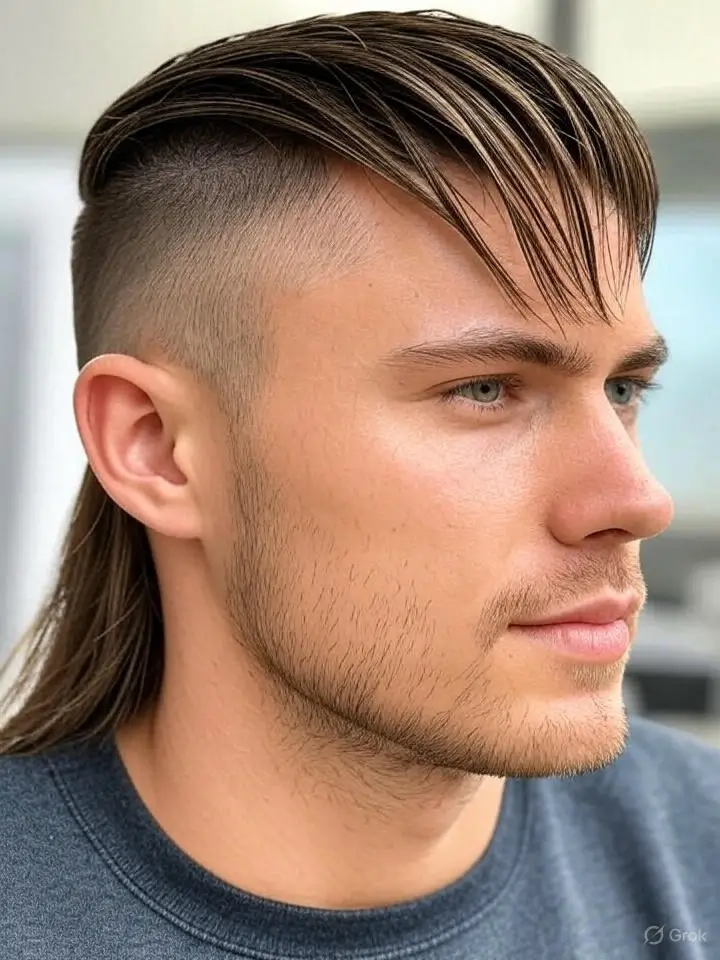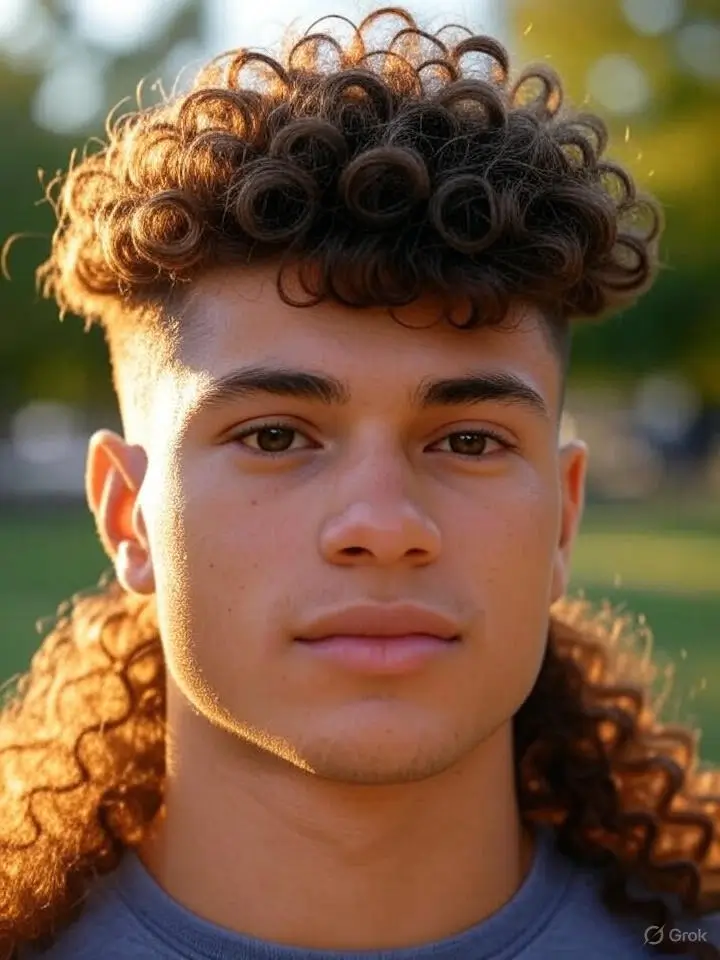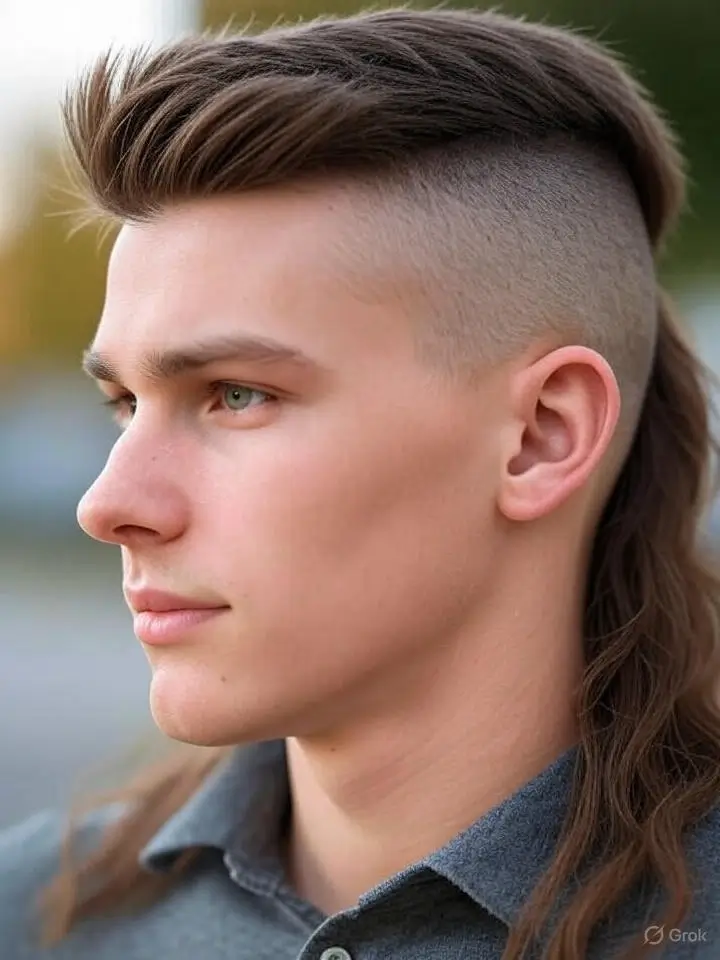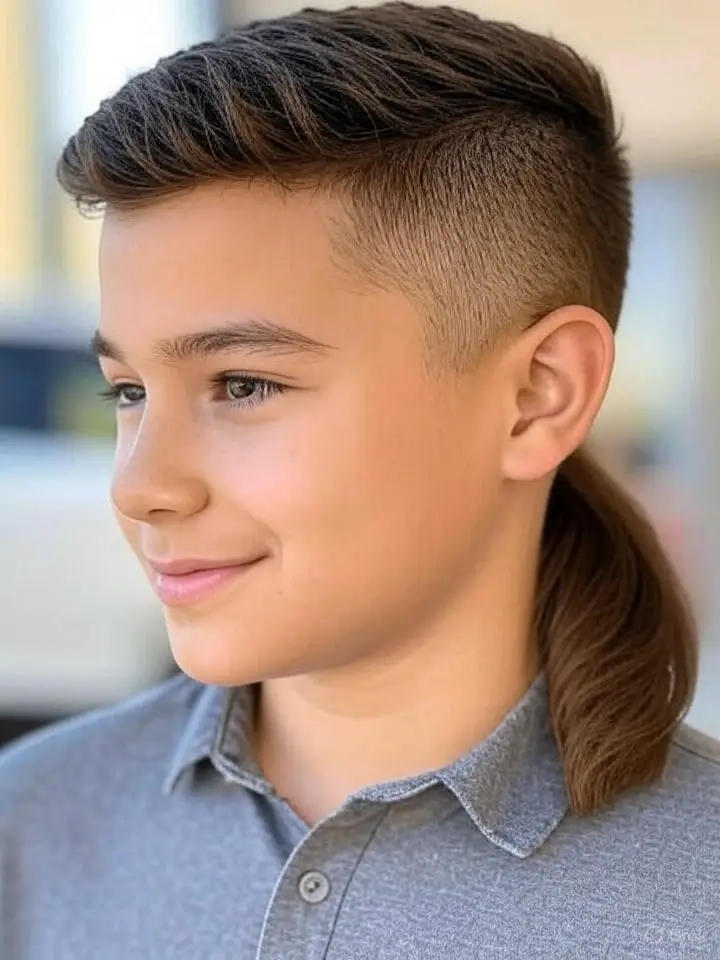Low Taper Mullet
The mullet, sometimes known as the “business in the front, party in the back” haircut, has made an impressive comeback in recent years. Among its modern variations, the low taper mullet stands out as a trendy, adaptable, and approachable alternative for men who want a bold yet sophisticated style. This haircut combines the distinctive mullet silhouette with the smooth, gradual fade of a low taper, resulting in a nostalgic vibe with contemporary flair. In this post, we’ll look at the low taper mullet, including its varieties, history, styling advice, and why it’s grown popular among Gen Z and beyond.
What is a Low Taper Mullet?
The low taper mullet is a hybrid hairstyle that combines the typical mullet (short on the sides and top, longer in the back) with a low taper fade. The low taper fade begins just above the ears and neckline, producing a delicate, smooth transition from short to long hair. This smooth blend reduces the mullet’s stark contrast, making it more presentable in everyday situations while maintaining its rebellious edge.
Key Features of the Low Taper Mullet
- Short Sides and Top: To achieve a clean, polished appearance, the sides and top are trimmed shorter, usually with a taper or fade.
- Longer Back: The back of the mullet is left longer and can be styled naturally or for volume.
- Low Taper Fade: A progressive fade begins low on the head and blends perfectly into the longer hair in the back.
- Versatility: Works with all hair types, including straight, curly, and wavy, and complements a variety of facial shapes.
History of the Mullet: From Retro to Revival
The mullet has a long history, dating back to ancient times, but it acquired widespread appeal in the 1970s and 1980s. The mullet was popularized by rock singers, athletes, and pop culture figures such as David Bowie and Patrick Swayze, and it came to represent a carefree, rebellious attitude. Its characteristic look—short on the sides and top, long in the back—made a strong statement.
By the 1990s, the mullet had fallen out of popularity and was frequently criticized as antiquated. However, the 2010s experienced a rebirth, fueled by nostalgia and a desire for unique, expressive haircuts. The modern mullet taper, which includes the low taper mullet, evolved into a sophisticated variant that incorporates fades and tapers to match current grooming trends. Today, the mullet is admired for its versatility and ability to combine retro charm with modern elegance.
Variations of the Taper Mullet
The taper mullet comes in a variety of styles, each with its own take on the iconic look. Below, we look at the most common versions, including options for different hair types and fade heights.
Low Taper Mullet for Straight Hair
The low taper mullet for straight hair is a modern take on the classic mullet, with a progressive fade on the sides and back that begins below the ears and blends seamlessly into longer hair at the top and back. This style keeps a clean, polished appearance with the distinctive mullet contrast—short in the front and sides, longer in the back—and straight hair adds a silky, smooth texture. Ideal for people looking for a dramatic yet versatile hairstyle, the low taper mullet can be done cleanly for professional situations or tousled for a relaxed, edgy look. It suits a variety of face types and is low-maintenance, requiring only frequent trims to maintain the taper sharp.

Low Taper Mullet for Curly Hair
The low taper mullet for curly hair features a modest fade on the sides and back, beginning lower around the ears, a voluminous crown, and a lengthier back, emphasizing curls’ inherent structure. This style’s beautifully tapered sides contrast sharply with the wild, bouncy curls at the top and back, making it a dramatic yet fashionable alternative. It’s suitable for both casual and formal styles, but regular trims are required to maintain the taper and keep the curls from becoming troublesome. The curly texture gives a distinct touch, heightening the mullet’s retro-modern appeal.

Mid Taper Mullet
The mid taper mullet has a moderate fade that begins midway up the sides and back, moving seamlessly into longer hair on top and a prominent back part, creating a balanced yet edgy appearance. This style looks well with straight or wavy hair, with a sleek front and sides and a larger, textured back that accentuates the mullet’s characteristic “business in the front, party in the back” look. It’s suitable for a variety of occasions, from casual outings to dressed-up parties, and requires frequent trims to keep the fade sharp. The mid taper mullet complements various facial shapes and gives a new spin to the historical haircut trend.

High Taper Mullet
The high taper mullet has a sharp fade that starts high on the sides and back, producing a dramatic contrast with the longer hair on top and the extended rear area, resulting in a bold and striking look. This style looks great with straight or wavy hair, providing a clean, modern look up front while embracing the mullet’s trademark voluminous rear for a rebellious edge. It’s perfect for those who desire a unique cut, but it takes periodic cuts to keep the high fade precise. The high taper mullet flatters a variety of face shapes and can be styled sleek or textured for every occasion.

Modern Mullet Taper
The modern mullet taper combines contemporary styling and the classic mullet, with a tapered fade on the sides and back that flows into a longer, textured top and rear area for a new yet bold look. This adaptable style may be worn with straight, wavy, or curly hair, and features a sleek front with a fun, voluminous back that pays homage to its classic roots. It’s low-maintenance and suitable for a variety of settings, from casual to semi-formal, with regular trims to keep the taper sharp. The trendy mullet taper complements a variety of facial types and can be styled with products for extra definition or a more relaxed look.

Modern Mullet Taper
The modern mullet taper combines contemporary styling and the classic mullet, with a tapered fade on the sides and back that flows into a longer, textured top and rear area for a new yet bold look. This adaptable style may be worn with straight, wavy, or curly hair, and features a sleek front with a fun, voluminous back that pays homage to its classic roots. It’s low-maintenance and suitable for a variety of settings, from casual to semi-formal, with regular trims to keep the taper sharp. The trendy mullet taper complements a variety of facial types and can be styled with products for extra definition or a more relaxed look.

Is a Low Taper Fade a Mullet?
A commonly asked question is, “Is a low taper fade a mullet?” The answer depends on the styling. A low taper fade is just a fading technique that gradually reduces hair length from top to bottom. When coupled with a longer back and shorter top and sides, it results in a low taper fade mullet. The mullet look is derived from the significant length contrast, while the low taper fade provides a modern, polished finish.
Why Does Gen Z Like Mullets?
The mullet’s resurgence among Gen Z can be attributed to several factors:
- Nostalgia and Retro Appeal: Gen Z like recreating retro trends, and the mullet’s 1980s feel complements their love of vintage apparel.
- Individuality: The mullet is a daring, nonconformist haircut that encourages self-expression and aligns with Gen Z’s emphasis on authenticity.
- Social Media Influence: Platforms such as TikTok and Instagram have popularized the mullet, with influencers and celebrities displaying current versions.
- Versatility: The mullet’s versatility with tapers, fades, and textures appeals to a wide spectrum of stylistic preferences.
Master the Modern Mullet: Hairstyles for Men
The modern mullet is all about balance, mixing the original mullet’s lively vitality with the clean lines of modern barbering. Here are some pointers for mastering the modern mullet:
- Choose the Right Fade: Choose a low, mid, or high taper based on your desired contrast and maintenance.
- Add Texture: To add movement and volume, use a texturizing product or have your barber create jagged layers.
- Experiment with Styling: The top can be combed forward, slicked back, or tousled to achieve varied looks.
- Consider Face Shape: Longer tops flatter oval faces, but shorter tops flatter round or square faces.
How to Create a Tapered Mullet with Smooth Transitions
Making a tapered mullet with seamless transitions takes talent and accuracy. Here’s a step-by-step tutorial for barbers and DIY enthusiasts:
- Section the Hair: Divide your hair into three sections: top, sides, and back. The back should be left longer to keep the mullet shape.
- Start the Taper: Begin the taper slightly above the ears, then gradually increase the length as you move up. To achieve a modest taper, keep the fade subtle and near to the neckline.
- Blend the Sides: Use a higher guard to merge the sides and top, resulting in a smooth transition with no hard lines.
- Shape the Back: Trim the back to your desired length, leaving it longer than the sides and top. Add texture layers as needed.
- Texturize the Top: Using scissors or a razor, add texture to the top to create movement and volume.
- Refine the Fade: Examine the taper with a lower guard to improve the fade’s smoothness, looking for any uneven patches.
- Style the Hair: Apply a style product, such as pomade or wax, to define the top and improve the flow of the back.
Tips for Maintaining a Low Taper Mullet
A low taper mullet requires constant maintenance to keep the fade sharp and the shape intact. Here are some useful tips:
- Regular Trims: Visit your barber every 3-4 weeks to keep the taper and prevent the back from growing too long or unmanageable.
- Style with Purpose: For straight hair, use a lightweight pomade or style cream, and for curly hair, use a curl-defining product to add texture.
- Protect the Hair: Avoid excessive heat styling and use a heat protectant if blow-drying to prevent damage.
- Clean the Neckline: Trim the neckline between barber sessions to maintain a professional appearance.
Conclusion
The low taper mullet is more than simply a hairstyle; it’s a statement of uniqueness that combines retro charm with contemporary refinement. Whether you choose a low taper mullet with straight hair, curly hair, a mid taper mullet, or a high taper mullet, this flexible style provides unlimited personalization options. Its popularity among Generation Z demonstrates its attractiveness as a bold, expressive choice for today’s trendsetters. By learning the technique of styling and upkeep, you will be able to confidently wear the low taper mullet, making it a classic addition to your grooming repertory. Visit your barber, play with textures, and embrace the mullet’s distinct look—because the party in the back is here to stay.